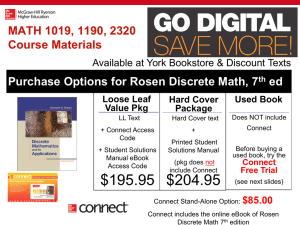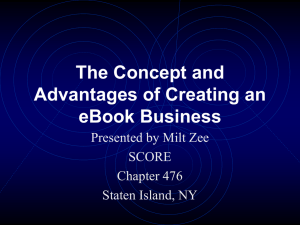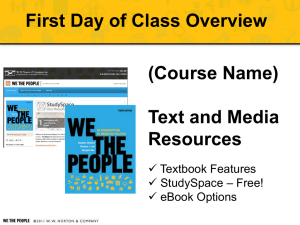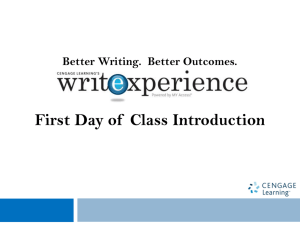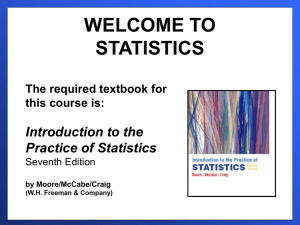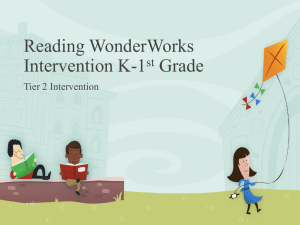FDLA-2015-Fall-Conference-Proposal-Form-John
advertisement
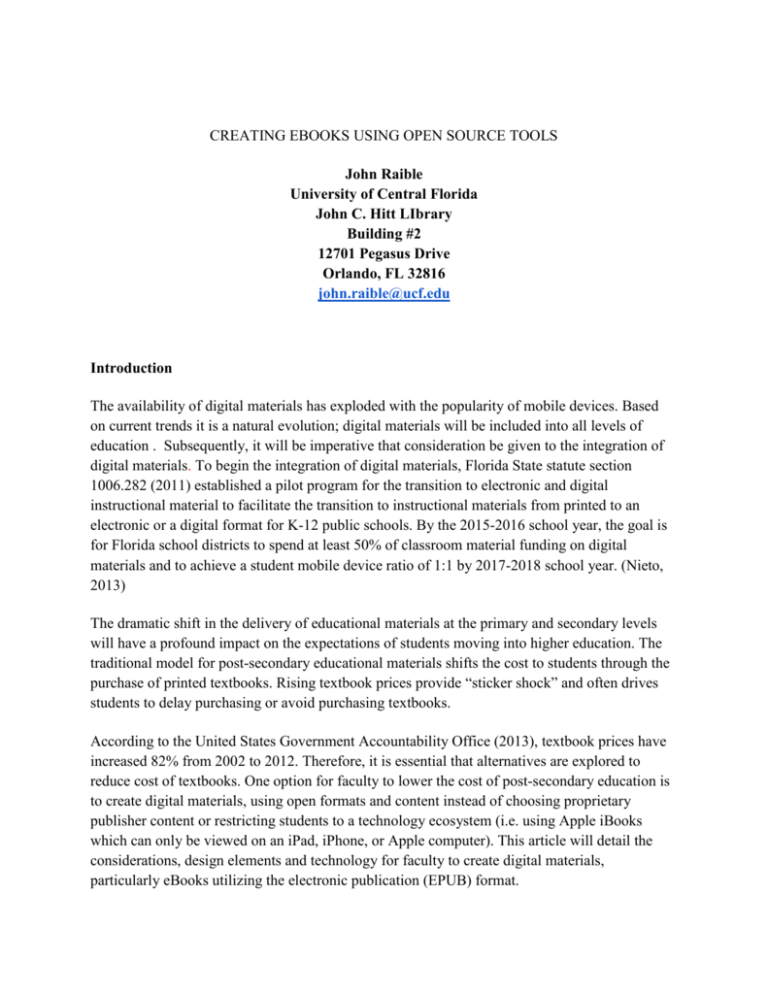
CREATING EBOOKS USING OPEN SOURCE TOOLS John Raible University of Central Florida John C. Hitt LIbrary Building #2 12701 Pegasus Drive Orlando, FL 32816 john.raible@ucf.edu Introduction The availability of digital materials has exploded with the popularity of mobile devices. Based on current trends it is a natural evolution; digital materials will be included into all levels of education . Subsequently, it will be imperative that consideration be given to the integration of digital materials. To begin the integration of digital materials, Florida State statute section 1006.282 (2011) established a pilot program for the transition to electronic and digital instructional material to facilitate the transition to instructional materials from printed to an electronic or a digital format for K-12 public schools. By the 2015-2016 school year, the goal is for Florida school districts to spend at least 50% of classroom material funding on digital materials and to achieve a student mobile device ratio of 1:1 by 2017-2018 school year. (Nieto, 2013) The dramatic shift in the delivery of educational materials at the primary and secondary levels will have a profound impact on the expectations of students moving into higher education. The traditional model for post-secondary educational materials shifts the cost to students through the purchase of printed textbooks. Rising textbook prices provide “sticker shock” and often drives students to delay purchasing or avoid purchasing textbooks. According to the United States Government Accountability Office (2013), textbook prices have increased 82% from 2002 to 2012. Therefore, it is essential that alternatives are explored to reduce cost of textbooks. One option for faculty to lower the cost of post-secondary education is to create digital materials, using open formats and content instead of choosing proprietary publisher content or restricting students to a technology ecosystem (i.e. using Apple iBooks which can only be viewed on an iPad, iPhone, or Apple computer). This article will detail the considerations, design elements and technology for faculty to create digital materials, particularly eBooks utilizing the electronic publication (EPUB) format. Purpose This paper attempts to show that faculty have a scope of choices for creating an eBook, ranging from simple to complex. A simple purpose is to create a supplemental resource. This resource can be used for easy access content in an academic, work, field, or service learning environment. The complex option involves replacing a current textbook. The time commitment needed for the replacing a textbook is great. Identifying the purpose of an eBook will maximize your efforts and resources. The main content challenge for creating eBooks is copyright. Obtaining copyright permission for text, music, images, and video may be a prolonged complex expensive process. The FAIR USE provision of the 1976 United States Copyright Act could be applied to content used in a eBook for educational use however, the content would have to pass the four factor criteria. The four factor criteria is comprised of the following questions: 1. The purpose and character of the use, including whether such use is of commercial nature or is for nonprofit educational purposes 2. The nature of the copyrighted work 3. The amount and substantiality of the portion used in relation to the copyrighted work as a whole 4. The effect of the use upon the potential market for, or value of, the copyrighted work (United States Copyright, 2012) While FAIR USE factor criteria may allow for the limited use of a copyrighted work, copyright challenges can be removed entirely by searching for open educational resources (OER). Atkins, Brown, & Hammond (2007) define OER as “teaching, learning, and research resources that reside in the public domain or have been released under an intellectual property license that permits their free use or re-purposing by others.” OER is an umbrella term which encompasses various types of resources which include lessons, guides, e-book, articles, audio tracks, videos, and multimedia. (UNESCO & Commonwealth of Learning, 2011). Choosing OER resources will save development time and avoid copyright complications. Despite the availability of OER materials, adoption rates of open textbooks. a type of OER, tend to be low. A survey of State of Florida higher education institutions revealed 33% reported no use while 41% reported uncoordinated efforts on campus to use open textbooks. (Adkins. et al., 2013) Individual faculty are implementing OER materials without support from the institution. This information clearly show efforts need to be made on campus to educate and support faculty in the adoption of OER materials. Design eBook design can mirror printed texts with a few different considerations. Decide on a consistent organizational scheme such as using chapter, section, or topics terminology to break up content. Once the book structure is defined, the design of individual eBook pages are similar to creating a web page. Headings, lists, and chunking content should be utilized in creating individual eBook pages. The author’s recommended practice is to build and layout content in a word processor before using eBook software. Instead of using Microsoft Word, use the Apache Foundation’s Open Office word processor. This program is available at no cost and provides the added benefit of retaining styles and formatting when importing content into eBook software. One key design element to address is the role of the Internet in your eBook. Ask yourself, should the eBook require an internet connection to view content? This decision can be addressed by the purpose of the eBook. If the eBook is meant to be consumed in a rural or workplace setting, internet connectivity may not be available. A suggestion is to include the majority of content without internet connectivity and clearly identify content which will need internet connectivity. This identification method will allow the reader to plan for internet connectivity when consuming the eBook. The inclusionsof media elements further leverage the benefits of creating an eBook. However, not all media can be included. To ensure compatibility, the following file formats should be employed: Images should use the JPEG or PNG format while video should use MP4, and audio use the MP3 format. It is important to note eBook software will not convert media into the recommended file formats. Images can be converted using the free online photo editing website called Pixlr. Audio can be edited and converted using Audacity while video can be converted using Handbrake. The conversion of media materials into the formats can be accomplished by faculty with the aforementioned software or faculty can utilize the appropriate institutional resources. Development As stated in the introduction, the open format for creating eBooks is EPUB. EPUB was created by the International Digital Publishing Forum as a method to produce and send a single digital publication file through distribution and offers interoperability between software/hardware using existing web standards (insert citation). This open format allows for the development of both proprietary and open sourced software. A suggested open source software product to create an eBook in the EPUB format is Sigil. Sigil is open source software maintained by volunteer software developers. Sigil is not as feature rich as a product such as Apple iBooks author however it has an intuitive interface and is available for Windows, Mac, and Linux. Implementation Once an eBook is created, there are several logistical factors for consideration before release. Student access, Digital Rights Management (DRM) and availability must be addressed to ensure a successful implementation for students. Student Access One advantage of the EPUB format is the ability to view an eBook from multiple devices. Students have the choice of installing an eBook reader app on iOS, Android or Microsoft mobile devices or using a computer with Google Chrome using the free Readium extension. A mobile and eTextbook survey conducted at the University of Central Florida found that students (N=707) who have used an eBook , 78% reported using a computer for access while only 16.5% reported using a tablet for access. (Chen & Denoyelles, 2013) These findings reinforce the need for content to be device or platform agnostic. DRM Digital rights management, often abbreviated DRM, is a process for managing the ownership and use of digital (computer coded) material. In effect, DRM software controls how a eBook’s owner may use and distribute the eBook. (Funk and Wagnalls, 2014). Commercial eBooks utilize DRM to control the number of devices the content may be accessed as well as the time (period) a reader has access to the eBook. If you are considering DRM for your content, please consult your general counsel's office for guidance as this action may have legal ramifications at your institution. Availability Another crucial decision to consider, is will your eBook be available publicly on the internet e.g. in an OER repository or linked on a commercial website) or restricted to your current students through a password protected environment (e.g. a learning management system). This decision will be based on your personal philosophy and legal requirements of your institution. Please consult your institution’s general counsel office on the legality of contributing materials to OER repositories. Evaluation Strategy The last step in the eBook creation process is to develop an evaluation strategy for students who have used your eBook. As a faculty member and author, it is important to collect student usage habits and beliefs. An EPUB file on the student device does not send student viewing data back to the author therefore a recommendation is to utilize an existing survey instrument to capture student usage habits and beliefs. Conduct a review of survey instruments presented in literature and based on the copyright license, use the survey, modify the survey or contact the author for permission to use. One example of a survey instrument is provided by Chen and deNoyelles (2013). They applied a creative commons 3.0 sharealike license to their survey instrument which includes eBook questions on usage and beliefs. Maintenance Strategy One of the added benefits of developing an eBook is that you, as the author, determine how and when the eBook is updated. The eBook has the capability of being updated throughout the semester! However, this ability raises the question of how often should an eBook be updated? The answer depends on several factors. In certain disciplines, new information is being generated frequently. The inclusion of this information will be driven by the purpose of your eBook. An alternative to including new information in the eBook is utilizing a different educational space (e.g. a Learning Management System or blog ). Another factor is the nature of the content. External videos and Web links must to be checked each semester to make sure the content is available, updated if the content is no longer available. The last and the most important factor are the results of a student survey about the eBook. The survey data will help identify commonly used features, areas of improvement, issues, and ideas for improvement. Conclusion There are still systemic issues, which need to be addressed to create an environment where eBook creation by faculty can thrive. The current environment provides no incentive for faculty to create eBooks at their respective institutions in place of writing books for publishers or having student purchase course materials. One eBook innovative is taking place at Boise State University. The goal is to provide faculty created eTextbooks to students at no cost, replacing textbooks provided by publishers. A faculty development program has been established to support faculty and they will be compensated for their time and effort. (L. Grover, personal communication, August 14, 2014) This type of institutional support should serve as an example of an innovative way to engage faculty to create eBooks. Famed science fiction writer Sir Arthur C. Clarke once said, “any sufficiently advanced technology is equivalent to magic.” The ability to take the printed word into the digital format may seen like “magic”, however, with a defined purpose, well-planned design and efficient use of development time will hopefully take the mystical mystery out of creating an eBook. References Adkins, R., Donaldson, R. and Opper, J. (2013). Use of Digital Textbooks and Course, Tallahassee, FL. Retrieved from http://www.rdonaldson.com/wp-content/uploads/2007/03/2012Digital-Course-Materials-Survey-Findings_03282013.pdf Atkins, D., Brown, J. & Hammond, A. (2007). A Review of the Open Educational Resources (OER) Movement: achievements, challenges, and new opportunities. Retrieved from http://www.hewlett.org/uploads/files/ReviewoftheOERMovement.pdf Chen, B., & Denoyelles, A. (2013). Exploring Students' Mobile Learning Practices in Higher Education. Educause Review Online. Digital rights management. (2014). Funk & Wagnalls New World Encyclopedia, 1p. 1. International Digital Publishing Forum. (2014). EPUB. Retrieved from http://idpf.org/epub Nieto, R. (2013). Digital Learning Update [PowerPoint slides]. Retrieved from http://www.fldoe.org/board/meetings/2013_11_19/November.pdf Pilot program for the transition to electronic and digital instructional materials. Fla. State. § 1006.282 (2011). UNESCO, Commonwealth of Learning. (2011). Guidelines for open educational resources (OER) in higher education. Retrieved from http://www.col.org/resources/publications/Pages/detail.aspx?PID=364 United States Copyright. (2012). Retrieved October 9th, 2014, from http://www.copyright.gov/fls/fl102.html United States Government Accountability Office. (2013). College Textbooks Students have Greater Access to Textbook Information (GAO-13-368). Washington, DC. http://www.gao.gov/products/GAO-13-368
